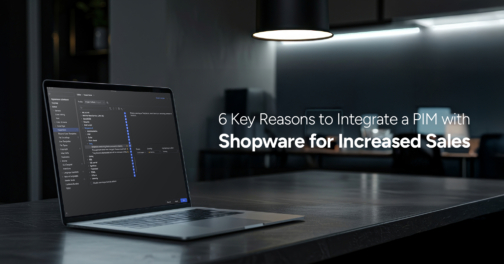Greetings! I'm Aneesh Sreedharan, CEO of 2Hats Logic Solutions. At 2Hats Logic Solutions, we are dedicated to providing technical expertise and resolving your concerns in the world of technology. Our blog page serves as a resource where we share insights and experiences, offering valuable perspectives on your queries.

Are you tired of managing scattered product data and struggling to maintain consistency across your Shopware store?
A Product Information Management (PIM) system can be the solution you’ve been looking for. Centralizing and optimizing your product information can unlock powerful benefits that drive sales and enhance customer experience.
What is PIM (Product Information Management)?
A PIM system is a centralized platform that helps businesses manage and distribute product information across various sales channels. For the Shopware user, this is a strategic move towards better product data management and increased sales efficiency.
The Challenge of Managing Product Data
E-commerce businesses face numerous challenges in managing product data:
- Multiple data sources and formats
- Inconsistent product information
- Time-consuming manual updates
- Complex multi-channel requirements
- Growing product catalogs
Why Shopware Needs a PIM Solution?
Current Limitations in Product Management
While Shopware 6 offers robust e-commerce capabilities, businesses often encounter limitations when managing large product catalogs:
- Manual data entry prone to errors
- Limited workflow automation
- Challenges in maintaining data consistency
- Time-consuming product updates
- Difficulty in managing multiple languages and channels
When to Implement PIM?
Implement PIM into your Shopware store, when you are facing:
- Product Complexity
- Business Expansion
- Data Quality Issues
- Resource Strain
6 Key Benefits of PIM-Shopware Integration
Product Information Management integration with Shopware has several advantages that enhance the efficiency and effectiveness of e-commerce operations.
Centralized product data management system: It creates a single source of truth for all product information. It ensures data is automatically validated and enriched, providing consistent product information across all sales channels and reducing redundancies and errors.
Improved product data quality: This will be achieved through standardized data formats and automated quality checks. This provides complete and correct product information, improving data management and trust in the product details shared with customers.
Faster Time-to-Market: This allows for the faster launch of new items in terms of time-to-market. It lowers manual involvement by supporting massive updates, making product development easier and faster, and automating workflow management.
Enhanced multi-channel capabilities: It improves multi-channel capabilities by making it simple to modify content for numerous channels, automating content distribution, ensuring consistent brand messaging, and ultimately increasing market reach.
Better customer experience: Rich and accurate product information, consistent across channels can improve customer’s product discovery experiences, resulting in fewer returns due to misinformation.
Easy product updates: They are made possible through centralized update management. Automation of synchronization guarantees that any platform is updated with new product information, with version control and track changes to assure accuracy.
Enhancing Sales Through PIM Integration
In addition to these benefits, PIM integration also significantly enhances sales efforts by improving:
Digital asset management: A media library facilitates the management of all visual content by centralizing access and making it ready for usage. Image optimization and automatic asset versioning help manage the entire digital content.
Enhanced collaboration: With role-based access control, team members can work more efficiently, benefiting from workflow automation that boosts productivity and fosters better communication.
Streamlined workflows: It simplifies business operations by automating approval processes, reducing manual tasks, and making things easier. This means better resource allocation, enabling the team to concentrate on value-added activities rather than repeated manual tasks.
Steps to integrate PIM to Shopware
Step 1: Define Integration Requirements
- Specify what data is to be synchronized, such as products, categories, attributes, and stock levels. Pinpoint the particular needs and aims for integrating the PIM with Shopware.
Step 2: Select a Compatible PIM Solution
Step 3: Ensure that the selected PIM supports integration with Shopware. This may include available plugins or APIs.
Step 4: Configuration of Your PIM System
- Create/upload and organize your product catalog in the PIM to include all necessary attributes and data points.
Step 5: Data Mapping Setup
- Map the data fields between PIM and Shopware so the information would be transferred correctly.
- The names of products, descriptions, prices, images, and other information from the PIM are mapped to the correct field in Shopware.
Step 6: Integration module development/installation
- If your PIM has a module for Shopware integration, you should follow the instructions to install and configure it.
- If not, you might have to write your integration using the APIs of both platforms (REST/SOAP).
Step 7: Configure API access. Configure API access on both PIM and Shopware. Test the integration.
Step 8: Configure a schedule to perform regular data synchronization between PIM and Shopware. This can be scheduled at night or even set to sync in real-time.
Step 9: Train your team members, and you are good to go, going live with monitoring.
Conclusion
PIM integration into a Shopware shop is not an option but a requirement for firms for scalable stores. When PIM and Shopware are merged, some of the biggest benefits lie in revenue increases, efficiency, and the enhancement of the customer interface.
For e-commerce businesses looking to scale, the question isn’t whether to integrate PIM with Shopware, but rather when and how to implement it most effectively. Take the first step today toward better product information management and increased sales through PIM-Shopware integration.
Ready to take your Shopware store to the next level? Our Shopware agency has experts ready to guide you on implementing the perfect PIM solution for your business needs.
FAQs
What challenges does PIM integration address for my e-commerce store?
PIM integration solves issues like inconsistent product information, time-consuming manual updates, and the challenge of managing data across multiple channels, helping streamline operations and improve efficiency.
How does PIM integration improve the quality of my product data?
PIM systems use standardized data formats and automated checks to maintain accurate, complete, and up-to-date product information, which boosts customer trust and reduces returns.
Is a PIM necessary if my Shopware store has a smaller catalog?
Even with a smaller catalog, PIM integration helps maintain data consistency and manage product details efficiently, especially as your business grows and adds more products or channels.
When should I consider implementing a PIM in my Shopware store?
Implementing a PIM can significantly improve efficiency and support growth if you're experiencing data inconsistencies, resource strain, or challenges in managing multiple channels,

Related Articles






